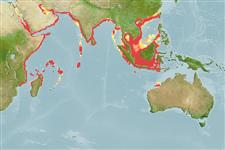Common names from other countries
Environment: milieu / climate zone / depth range / distribution range
Sinh thái học
; Mức độ sâu 9 - 160 m (Ref. 103583). Tropical; 31°N - 19°S, 32°E - 121°E (Ref. 1695)
Indo-West Pacific: from Indian Ocean to Indonesia and southern South China Sea.
Length at first maturity / Bộ gần gũi / Khối lượng (Trọng lượng) / Age
Maturity: Lm 6.1 range ? - ? cm Max length : 12.5 cm ML con đực/không giới tính; (Ref. 275)
Females grow larger than males (Ref. 3722). Feeds on small demersal fishes, crustaceans, other cephalopods (Ref. 275).
Members of the class Cephalopoda are gonochoric. Male and female adults usually die shortly after spawning and brooding, respectively. Mating behavior: Males perform various displays to attract potential females for copulation. During copulation, male grasp the female and inserts the hectocotylus into the female's mantle cavity where fertilization usually occurs. Life cycle: Embryos hatch into planktonic stage and live for some time before they grow larger and take up a benthic existence as adults.
Jereb, P. and C.F.E. Roper (eds.). 2005. (Ref. 1695)
IUCN Red List Status (Ref. 130435)
CITES status (Ref. 108899)
Not Evaluated
Not Evaluated
Human uses
Các nghề cá: Tính thương mại
| FishSource |
Các công cụ
Các nguồn internet
Estimates based on models
Preferred temperature
(Ref.
115969): 22.5 - 28.6, mean 27.3 (based on 743 cells).
Thích nghi nhanh
Chiêù cao, thời gian nhân đôi của chủng quần tối thiểu là dưới 15 tháng (K=0.52-2.25).
Vulnerability
Low vulnerability (10 of 100).
